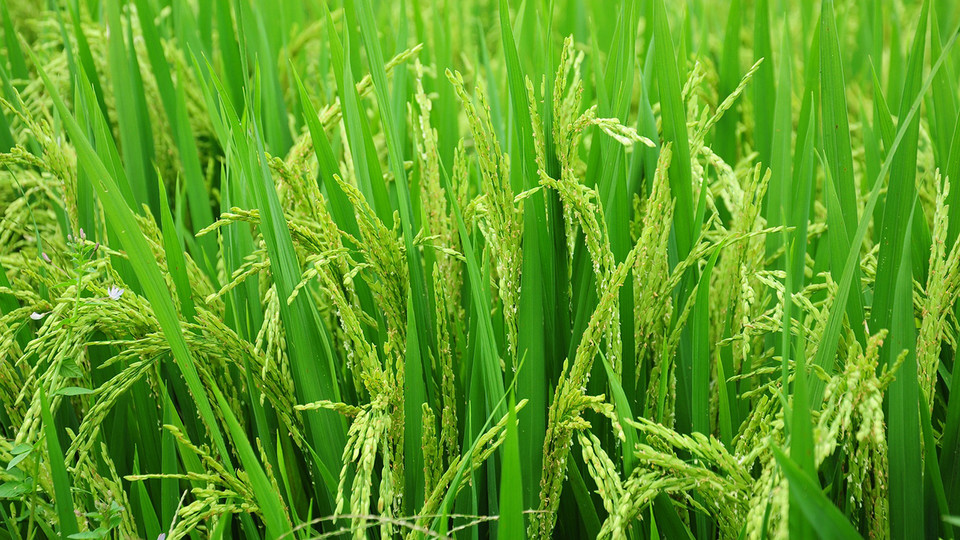
Even with the largest population on the planet, China produces enough rice to meet the demand for its largest food crop.
Scientists have questioned whether China can remain self-sufficient as mass migration to the cities increases competition for water and land. A new global yield-gap analysis by agronomists from the University of Nebraska-Lincoln and Huazhong Agricultural University found that China is likely to be able to meet demand, even as land use changes. The team’s findings were published April 12 in Nature Communications.
Using primary data on Chinese rice production and the information gathered via the Global Yield Gap Atlas developed at Nebraska, the study gives the first detailed spatial analysis estimating China’s rice production potential through 2030. The advantage of the Global Yield Gap’s “bottom-up” approach is that agronomists are gathering soil, water and climate data directly from the field, with the goal of uncovering potential for growing more crops on existing farmland.
“This work is important because it can help China precisely identify the regions and rice-cropping systems that have the greatest potential for return on research and development investments,” said Shaobing Peng, the study’s lead author and professor of crop physiology at Huazhong Agricultural University.
Impact on global rice markets
China produces 28 percent of the world’s rice supply, and its production decisions have majorly influenced global markets.
“China is the elephant in the room with respect to global rice markets,” said Nebraska’s Patricio Grassini, associate professor of agronomy and horticulture. “Accurate estimates of China’s current and future production potential are essential for strategic planning not just for China, but for global food security, land use and grain markets.”
This study provides the first field-level, robust estimate of rice production across China’s vast growing area extending from the country’s southern tropics to the cold northern plains.
“This work is an example of the world-leading research at Nebraska addressing the growing food demands and changing climate that are increasing the complexity of agriculture,” said Bob Wilhelm, vice chancellor for research and economic development. “These tools and analyses have immediate impact and support future improvements in food production.”
Top-down versus bottom-up approach
Previous studies in China used a top-down approach, predicting yield potential based on large-scale crop and weather data. In those studies, yield potential was estimated using maximum farm yields or generic, poorly validated crop models, rather than one tailored for rice production. That approach also did not account for how land management practices or local weather patterns can affect yield potential for a specific field.
Nebraska’s yield-gap analysis estimates the difference, or gap, between current farm yields and potential yields if producers minimize losses from nutrient deficiencies, pests and diseases. It starts from the bottom, using field-specific data: at least 10 years of daily weather records, digital maps of current rice-production areas, yield data and information on rice-cropping systems and management practices.
“Comparing bottom-up versus top-down analyses in this project was critical,” said Kenneth Cassman, Robert B. Daugherty Professor Emeritus of agronomy.
The latest yield-gap analysis is China’s first estimate based on real-time, location-specific agronomic data that is scaled up to the provincial and national levels. This gives China an opportunity to look at rice-production capacity in a way it has never been able to do, Cassman said.
Focus on cropping systems
Location-specific cropping-system data used in the analysis illustrated the shifts in China’s rice production systems since the 1980s. The double-rice system — planting two crops annually on the same field — in the warm southern regions that once accounted for 66 percent of the total harvested rice area is now at less than 40 percent.
Although acreage dedicated to single-rice systems — one crop per year — in the cooler central and northern regions has steadily increased, it is not enough to replace losses in the south. The result: China’s total harvested rice area has decreased 3.6 million hectares since 1980.
The study showed that focusing resources on increasing yields in double-rice systems and in three provinces that have single-rice systems with sizable yield gaps offers the greatest potential to ensure China continues growing enough rice for its population.
“The good news is that China has substantial flexibility to maintain self-sufficiency without increasing the cropland dedicated to rice production,” said Nanyan Deng, postdoctoral researcher at Huazhong Agricultural University.
The Global Yield Gap Atlas is a collaboration among Nebraska, the Daugherty Water for Food Institute at the University of Nebraska, and Wageningen University and Research in the Netherlands.
Nebraska Today
Monica Norby | Research and Economic Development
More details at: https://go.unl.edu/kcs2